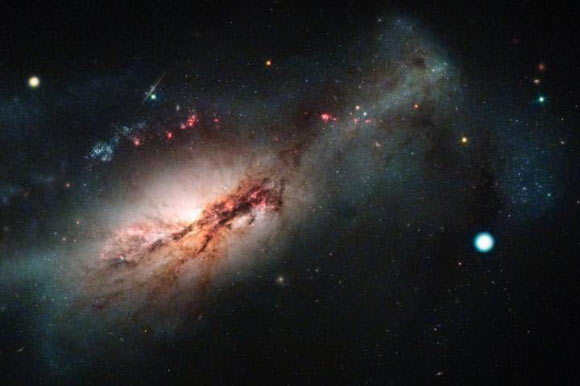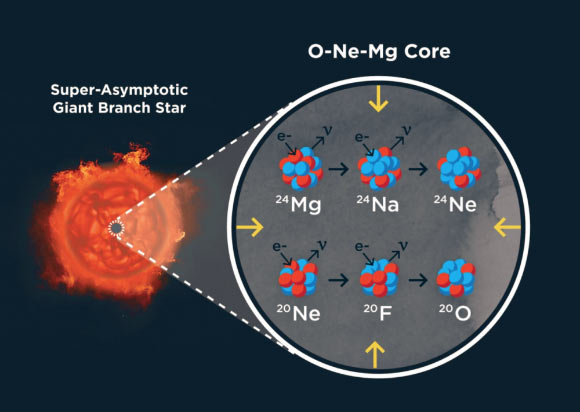An international team of astronomers has discovered the first convincing evidence for an electron-capture supernova, which is thought to arise from the explosions of massive super-asymptotic giant branch stars.

Las Cumbres/Hubble composite image of the electron-capture supernova SN 2018zd (the large white dot on the right) and the host starburst galaxy NGC 2146 (toward the left). Image credit: NASA / ESA / Hubble / STScI / J. DePasquale, Las Cumbres Observatory.
“One of the main questions in astronomy is to compare how stars evolve and how they die. There are many links still missing, so this is very exciting,” said Professor Stefano Valenti, an astronomer in the Department of Physics at the University of California, Davis.
Historically, there have been two main supernova types: thermonuclear supernovae and iron core-collapse supernovae.
A thermonuclear supernova is an explosion of a white dwarf star after it gains matter in a binary star system. These white dwarfs are the dense cores that remain after a low-mass star — one up to about 8 times the mass of the Sun — reaches the end of its life.
In an iron core-collapse supernova, a massive star — one more than about 10 times the mass of the Sun — runs out of nuclear fuel and has its iron core collapse, creating a black hole or neutron star.
First predicted in 1980 by University of Tokyo astronomer Dr. Ken’ichi Nomoto, the electron-capture supernovae are on the borderline between these two types of supernovae.
“While gravity is always trying to crush a star, what keeps most stars from collapsing is either ongoing fusion or, in cores where fusion has stopped, the fact that you can’t pack the atoms any tighter,” the astronomers explained.
“In an electron capture supernova, some of the electrons in the oxygen-neon-magnesium core get smashed into their atomic nuclei in a process called electron capture.”
“This removal of electrons causes the core of the star to buckle under its own weight and collapse, resulting in an electron-capture supernova.”
In the new study, the researchers focused on a supernova event called SN 2018zd, which was detected in March 2, 2018.
They found that this stellar explosion had many unusual characteristics, some of which were seen for the first time in a supernova.
It helped that SN 2018zd was relatively nearby — only 31 million light-years away — in the outskirts of NGC 2146, a barred spiral galaxy in the constellation of Camelopardalis.
This allowed the team to examine archival images taken prior to the explosion from the NASA/ESA Hubble Space Telescope and to detect the likely progenitor star before it exploded.
The observations were consistent with another recently identified super-asymptotic giant branch (SAGB) star in the Milky Way, but inconsistent with models of red supergiants, the progenitors of normal iron core-collapse supernovae.
The scientists looked through all published data on supernovae, and found that while some had a few of the indicators predicted for electron-capture supernovae, only SN 2018zd had all six: an apparent SAGB progenitor, strong pre-supernova mass loss, an unusual stellar chemical composition, a weak explosion, little radioactivity, and a neutron-rich core.
“We started by asking ‘what’s this weirdo?’ Then we examined every aspect of SN 2018zd and realized that all of them can be explained in the electron-capture scenario,” said Daichi Hiramatsu, a graduate student in the Department of Physics at the University of California, Santa Barbara and Las Cumbres Observatory.

Artist’s impressions of a super-asymptotic giant branch star (left) and its core (right) made up of oxygen (O), neon (Ne), and magnesium (Mg); a super-asymptotic giant branch star is the end state of stars in a mass range of around 8-10 solar masses, whose core is pressure supported by electrons (e-); when the core becomes dense enough, neon and magnesium start to eat up electrons (so-called electron-capture reactions), reducing the core pressure and inducing a core-collapse supernova explosion. Image credit: S. Wilkinson, Las Cumbres Observatory.
The discovery also illuminates some mysteries of SN 1054, the famous supernova that occurred in the Milky Way in 1054 CE.
According to Chinese records the explosion was so bright that it could be seen in the daytime for 23 days, and at night for nearly two years. The resulting remnant — the Crab Nebula — has been studied in great detail.
SN 1054 was previously the best candidate for an electron capture supernova, but this was uncertain partly because the explosion happened nearly a thousand years ago.
The new result increases the confidence that the event was an electron capture supernova.
“I’m very pleased that the electron capture supernova was finally discovered, which my colleagues and I predicted to exist and have a connection to the Crab Nebula 40 years ago,” Dr. Nomoto said.
“This is a wonderful case of the combination of observations and theory.”
The team’s paper was published in the journal Nature Astronomy.
_____
D. Hiramatsu et al. The electron-capture origin of supernova 2018zd. Nat Astron, published online June 28, 2021; doi: 10.1038/s41550-021-01384-2







